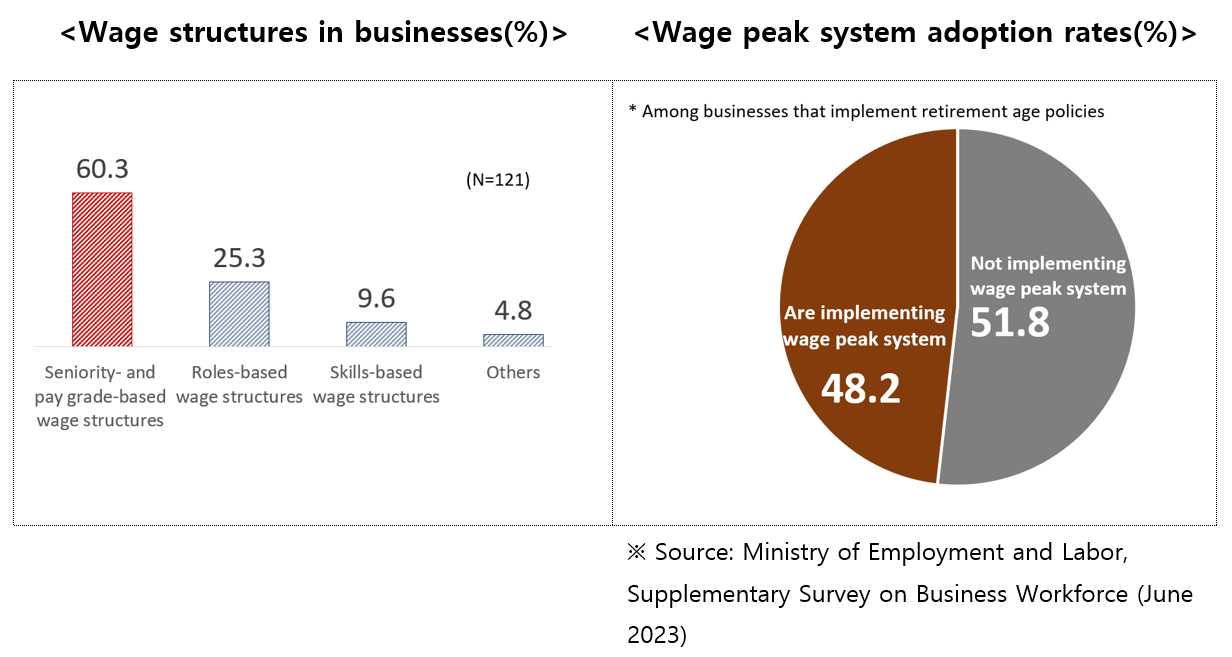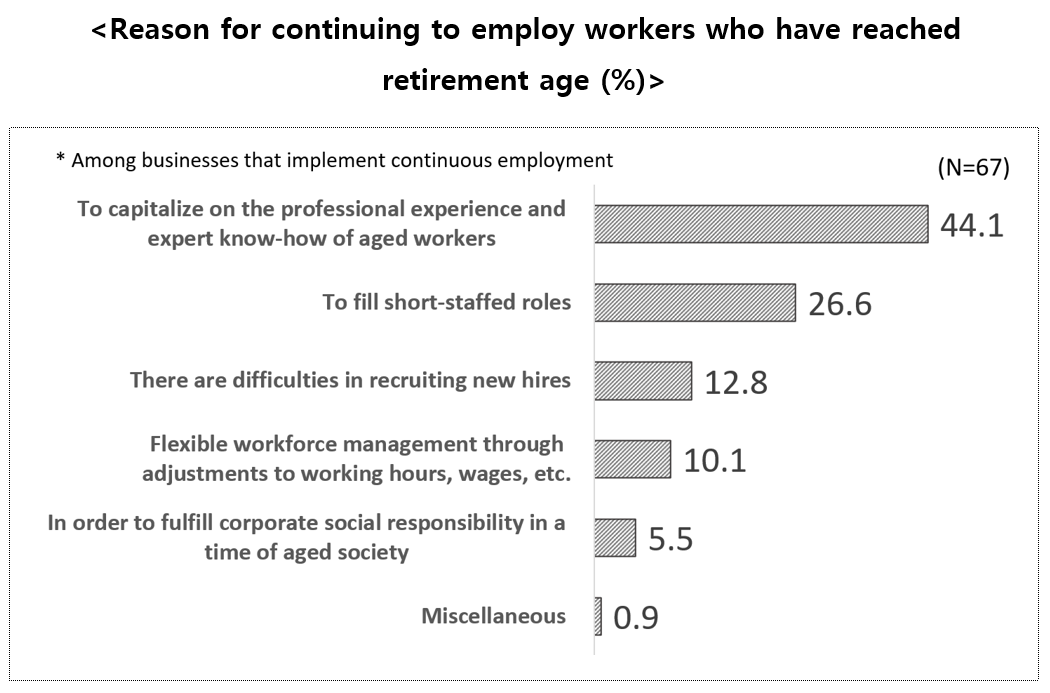News & Events
Press Releases
Survey: Business Perceptions on Elderly Employment Policies
|
Among businesses, 7 of 10 (67.8%) report that an extension of the retirement age would be a burden due to seniority- and pay grade-based wage structures.
- Survey: Business Perceptions on Elderly Employment Policies -
• Why an extension of the retirement age would burden businesses: Increased payroll burden due to seniority-based wage structures (26.0%); Worsening personnel congestion (23.2%)
* Among companies with 300+ workers, 60.3% have seniority-based wage structures; 25.3% have roles-based wage structures; 9.6% have skills-based wage structures; and 4.8% have other wage structures.
• Among companies, 71.9% prefer to reemploy a worker after they have retired if the continuous employment policy is implemented... this may allow for labor market flexibility
• More than half of the businesses surveyed (52.2%) report cases of continuous employment of workers who have reached retirement age, and businesses prefer to reemploy outstanding workers who have retired
• Establishing an environment for elderly employment requires: Labor cost support (28.1%); Tax benefits (24.0%); and Revamping wage structures (22.3%), etc.
Among businesses, 7 of 10 (67.8%) report that an extension of the retirement age would be a burden due to seniority- and pay grade-based wage structures. This figure is twice as high as the proportion of businesses that reported an extension of the retirement age would not be a burden (32.2%).

According to the survey, 6 of 10 businesses (60.3%) are currently implementing seniority- and pay grade-based wage structures, and if the retirement age were extended, labor cost burdens would rise sharply. The FKI noted potential side-effects, such as significant increases in labor costs, which may follow premature implementation of an extension of the retirement age. This concern arises because as of June 2023, the adoption rate of the wage peak system1) among businesses with 300+ workers is less than half (48.2%). The wage peak system, introduced in 2013, was proposed to help alleviate cost burdens on businesses following the legislation to raise the retirement age to 60; at a time when seniority- and pay grade-based wage structures were the prevailing wage systems.
1) A wage system in which employment is maintained until retirement, but wages are reduced at a certain age.

Among companies, 71.9% prefer to reemploy a worker after they have retired if the continuous employment policy is implemented...
this may allow for labor market flexibility
Much attention is being directed toward discussions on expanding elderly employment as Korea rapidly transitions into an aged society. In this context, the Economic, Social & Labor Council (ESLC), a presidential advisory body that promotes dialogue between labor, management, and government, announced2) that it plans to reach a social consensus on a continuous employment policy3) by the first quarter of next year. In the case a continuous employment policy is introduced, 7 of 10 businesses (71.9%) answered that they preferred ‣Reemployment after workers retire (71.9%). Other options include, in descending order: ‣Extending the retirement age (24.8%); and ‣Abolishing the retirement age (3.3%).
2) “Our primary goal is to reach a conclusion on continuous employment for seniors by the first quarter of next year at the latest.”
(Ki-seop Kwon, chairman of the ESLC, at a press conference on October 28, 2024)
3) A policy which reemploys retired workers or extends the retirement age, or abolishes the retirement age of workers who have reached retirement age.
Businesses cited several reasons for preferring the Reemployment after workers retire approach. These include, in descending order: ‣It allows for labor market flexibility (35.2%); ‣Enables continuous employment of workers who meet certain criteria, such as possessing professional expertise or expressing a desire for continuous employment (25.8%); and ‣Allows wage level adjustments linked to the productivity of aged workers (24.5).

More than half of the businesses surveyed (52.2%) report having cases of continuous employment of workers having reached retirement age,
and businesses prefer to reemploy outstanding workers who have retired
It was found that the practice of reemploying retired workers to capitalize on the professional experience and know-how of aged workers with expertise was common at industrial sites. Among businesses that implement retirement age policies, 60.4% reported having kept employed workers who had reached retirement age. The preferred approaches of continuous employment were, in descending order: ‣Reemploying outstanding workers (52.2%); ‣Reemploying workers who expressed their desire for reemployment (29.8%); and ‣Reemploying all retiring workers (9.0%).

Businesses that had a history of employing workers who have reached retirement age reported that the biggest reason for doing so was: ‣To capitalize on the professional experience and know-how of aged workers with expertise (44.1%). Other reasons included: ‣To fill short-staffed roles (26.6%); and ‣There are difficulties in recruiting new hires (12.8%).

The FKI analyzed, “The approach of ‣Reemployment after workers retire has advantages, such as being able to adjust working hours and wages according to the productivity of aged workers. This may positively impact workforce management efficiency as well as workers satisfaction at the workplace, enabling businesses to employ aged workers effectively.”
Establishing an environment for elderly employment requires Support for labor costs (28.1%); Tax benefits (24.0%);
and Revamping wage structures (22.3%), etc.
Businesses responded that the biggest HR and labor management challenges that would follow employment of aged workers include: ‣Responding to health issues and industrial accident risks of aged workers (28.9%); ‣Decrease in productivity (28.9%); and ‣High payroll burdens (24.8%).
The government and the legislature would need to proactively focus on implementing the following measure to establish an environment conducive to continuous employment of the elderly: ‣Expand support for labor costs that would follow recruitment of elderly workforce. Other measures include, in descending order: Tax benefits for employing aged workers (24.0%); ‣Improving amendment procedures to rules of employment to facilitate revamping of wage structures (22.3%); ‣Easing regulations on temporary agency workers and fixed-term employees to allow for flexibility in workforce management.
Sang-ho Lee, head of FKI’s Economic and Industrial Research Department, emphasized, ”Employing aged workers within an inflexible labor market and under wage structures that fail to reflect productivity would put an excessive burden on businesses.” He added, “Instead of drawing a blanket extension of the retirement age, we should cultivate an environment where businesses can actively employ elderly workers. This approach would require expanding benefits to businesses that employ aged workers and revamping wage structures to better reflect job responsibilities and productivity.”
